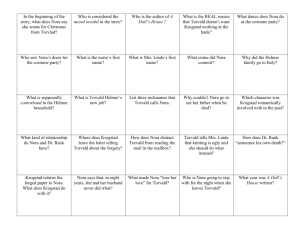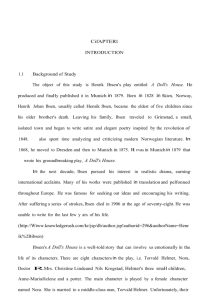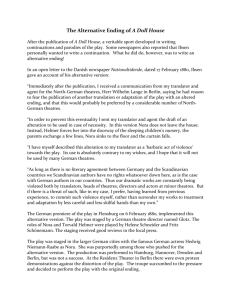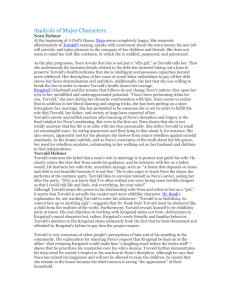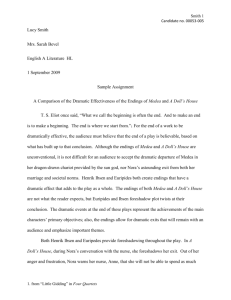A Doll*s House: During Reading - Ms. Lesniak`s Sophomore English
advertisement
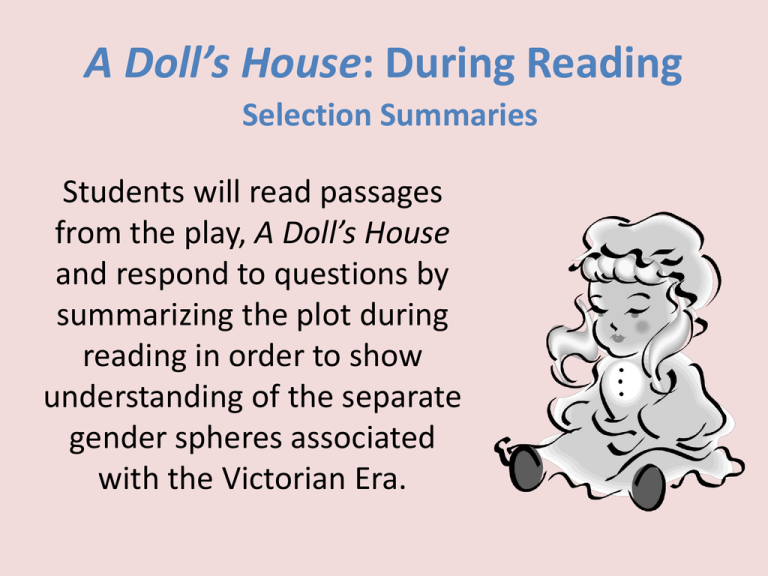
A Doll’s House: During Reading Selection Summaries Students will read passages from the play, A Doll’s House and respond to questions by summarizing the plot during reading in order to show understanding of the separate gender spheres associated with the Victorian Era. About the Author Pre-Reading • Read each of the following sections on page 940-941 and fill in important information on your notesheet. • You will have 15 minutes to complete the notes. About the Author Pre-Reading Henrik Ibsen •Critics & audiences hated Ibsen’s work because he was a literary pioneer. •Creator of modern realistic drama. •First modern writer to use drama to explore socially unacceptable issues. •Greatest and most influential dramatist of the 19th century. Difficult Beginnings •Family was very poor. •Hired as a playwright for The National Theater of Bergen. Career in Theater •Most popular play Brand was written in 1866. •Became a popular playwright from this point forward. About the Author Pre-Reading Controversial Art •A Doll’s House was not liked by the public because it portrayed a woman whose actions were unacceptable. Modern Realistic Drama: A type of play unlike anything audiences has seen before. 1. Reflects ordinary language. 2. Depicts characters and situations as they really are. 3. Addresses controversial issues and society’s assumptions. Act 1: Selection Summary 1 P.943 • Read the stage directions at the beginning of Act 1. • List four details from the passage that indicate the Helmer’s social standing. 1. 2. 3. 4. 5. 6. 7. 8. 9. Tastefully furnished Study Piano Porcelain stove Small art objects China figures Books Fire Carpet Act 1: Selection Summary 2, pp. 943-946 • • • • List the nicknames Torvald calls Nora. What is Torvald’s attitude toward money? What is Nora’s attitude toward money? How would you describe the roles Torvald and Nora have in their marriage? Torvald calls Nora “little lark” and “my squirrel.” He views her as a child and shakes his finger at her and interrogates her about the macaroons. Nora, on the other hand, is obedient to Torvald and lies about her actions to appease him. Nora is presented as a spendthift, while Torvald is against borrowing money because it eliminates the freedom of the borrower. Their marriage is essentially unstable where Nora is limited to the decisions of her husband, Torvald. Act 1: Selection Summary 3, pp. 947-949 • Review the gestures Nora displays while talking with Torvald. • How are her gestures indicative of her childlike role in her marriage? • Who is expected to join the Helmer’s for dinner? What does this reveal about Torvald’s previous health? • Who arrives at the Helmer’s home? How is her social status different than Nora’s? Nora claps her hands excitedly when she and Torvald speak; she doesn’t like to be teased. Nora and Torvald talk about Dr. Rank coming for dinner later, which sheds light on Torvald’s previous illness that required the Helmer’s to travel to a warmer climate which was a great expense. In addition, Nora’s old friend Mrs. Linde arrives. Kristine is a widow without children who has suffered hard times; while Nora is concerned with “stacks of money,” Kristine is only focused on being sensible and “the necessities.” The two women are a contrast to each other. Act 1: Selection Summary 4, pp 950-951 • • • • From whom did Nora get the money to travel to Italy? For what reasons did Kristine marry her husband? What is Kristine’s motive for visiting Nora? Predict: What is Nora’s “big thing” she has yet to reveal? Nora got the money to take Torvald to Italy as per Doctor’s orders from her father who later passed away. In their discussion, Kristine reveals to Nora that she married her husband with whom she did not love for financial security reasons; she needed to care for her sick mother and two younger brothers at the time. Without his income, she has faced exhausting work days which Nora cannot empathize with. In order to dramatize her own hardships, Nora reveals that she has her own troubles which most likely have to deal with finances and foreshadowed by earlier conversations with her husband.

